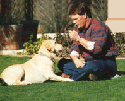|
The practice of dog training has been relatively static for about 10,000 years. You can find pictographs in Egypt that show "slip collars" -- the leather predecessor of the choke-chain. Other than material, it's the same thing. You can find Roman art that shows dogs with spiked collars and European art that shows dog training in the middle ages -- it's all pretty much the same: A choke type collar on one end and a jerk on the other.
That makes clicker training the first major improvement in dog training in about 15,000 years. How is this method different than all the other things people have tried? Clicker training is the first pespective on training that breaks the process down into two things -- information and motivation. Traditional dog trainers attempt to do both at the same time -- verbal praise is used to mark good behavior AND motivate the dog to repeat the behavior. In clicker training, these two different tasks are specifically broken down into. two separate tasks, using two separate tools.
While this may seem to be an inconsequential thing, it's not. At the very base of all learning, the brain has to know what it must do to adapt to the environment -- whether the environment is the wilderness or your home. Once a behavior is known to be functional, the most important question of all must be correctly answered -- "Why would I do that?" When you use verbal praise to attempt to give the dog information about what behavior matches the situation AND be a motivation to do it again, you're trying to stretch one tool into two. Unfortunately, learning doesn't adapt well to a Swiss Army Knife approach. A signal designed to pass information has to be quick. Verbal praise that motivates has to take a while to get the dog excited. If you lengthen the information signal, you make it less precise. That's why clicker training seems to be incredibly quick compared to traditional training -- the information signal is as precise as a camera with a very fast shutter. The animal discovers the pieces to the puzzle more accurately and thereby more quickly.
To get the hang of this, it's a lot better to actually try it than to attempt to imagine the concepts underlying the method. The average dog can give you a pretty good idea of how this works in about 20 minutes. So run down to PetSmart or PetCo and get a clicker. Come home and hit the link to Click Start - it's a basic look at clicker training with some simple exercises that will convince you that you should jump in with both feet or find some other method of training. Either way, feel free to email me if you have any questions or comments. wilkesgm@aol.com
.
|




